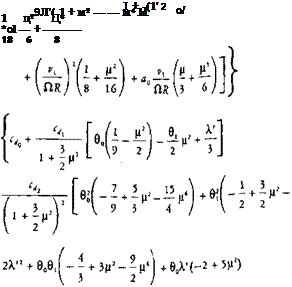Three-Term Drag Polar
Another refinement to the closed-form equations involves the use of an expression for the coefficient of drag as a function of the local angle of attack rather than of a single average value. The classical form, which was discussed in Chapter 1, is the three-term power series—usually referred to as a three-term drag polar:
|
|
|
|
|
|
|
|
|
|
|
|
 |
![]()
![]() + 0,А'(—2 + Зр2)
+ 0,А'(—2 + Зр2)
1 + – р
2
Airfoil data are usually better fit with a power series with more than three terms, but the use of any power above the second leads to difficulties in the integration which do not justify the increased accuracy that might result. The three constants
in the drag polar should be chosen to fit the airfoil data at a representative Mach number corresponding to 75% of the tip speed and the highest angle of attack on the retreating side. A discussion of the problem of fitting a three-term polar to test data was given in Chapter 1, and Figure 1.37 shows three polars that approximate the NACA 0012 data.











